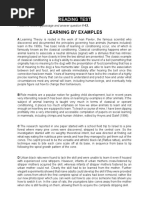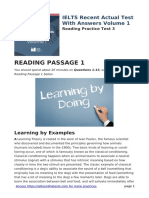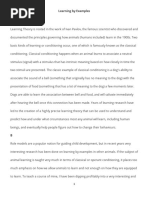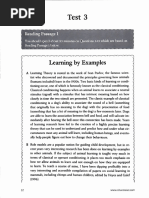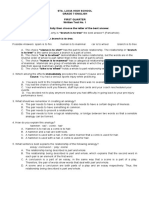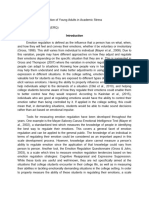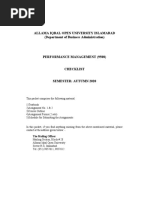Learning by Examples
Learning by Examples
Uploaded by
AnCopyright:
Available Formats
Learning by Examples
Learning by Examples
Uploaded by
AnOriginal Title
Copyright
Available Formats
Share this document
Did you find this document useful?
Is this content inappropriate?
Copyright:
Available Formats
Learning by Examples
Learning by Examples
Uploaded by
AnCopyright:
Available Formats
Reading Practice
Learning by Examples
A Learning Theory is rooted in the work of Ivan Pavlov, the famous scientist who
discovered and documented the principles governing how animals (humans included) learn
in the 1900s. Two basic kinds of learning or conditioning occur, one of which is famously
known as the classical conditioning. Classical conditioning happens when an animal learns
to associate a neutral stimulus (signal) with a stimulus that has intrinsic meaning based on
how closely in time the two stimuli are presented. The classic example of classical
conditioning is a dog's ability to associate the sound of a bell (something that originally has
no meaning to the dog) with the presentation of food (something that has a lot of meaning
to the dog) a few moments later. Dogs are able to learn the association between bell and
food, and will salivate immediately after hearing the bell once this connection has been
made. Years of learning research have led to the creation of a highly precise learning
theory that can be used to understand and predict how and under what circumstances
most any animal will learn, including human beings, and eventually help people figure out
how to change their behaviours.
B Role models are a popular notion for guiding child development, but in recent years very
interesting research has been done on learning by examples in other animals. If the subject
of animal learning is taught very much in terms of classical or operant conditioning, it
places too much emphasis on how we allow animals to learn and not enough on how they
are equipped to learn. To teach a course of mine, I have been dipping profitably into a very
interesting and accessible compilation of papers on social learning in mammals, including
chimps and human children, edited by Heyes and Galef (1996).
C The research reported in one paper started with a school field trip to Israel to a pine
forest where many pine cones were discovered, stripped to the central core. So the
investigation started with no weighty theoretical intent, but was directed at finding out what
was eating the nutritious pine seeds and how they managed to get them out of the cones.
The culprit proved to be the versatile and athletic black rat,(Rattus rattus), and the
technique was to bite each cone scale off at its base, in sequence from base to tip following
the spiral growth pattern of the cone.
D Urban black rats were found to lack the skill and were unable to learn it even if housed
with experienced cone strippers. However, infants of urban mothers cross-fostered by
stripper mothers acquired the skill, whereas infants of stripper mothers fostered by an
urban mother could not. Clearly the skill had to be learned from the mother. Further elegant
experiments showed that naive adults could develop the skill if they were provided with
cones from which the first complete spiral of scales had been removed; rather like our new
photocopier which you can work out how to use once someone has shown you how to
switch it on. In the case of rats, the youngsters take cones away from the mother when she
is still feeding on them, allowing them to acquire the complete stripping skill.
E A good example of adaptive bearing we might conclude, but let’s see the economies.
This was determined by measuring oxygen uptake of a rat stripping a cone in a metabolic
chamber to calculate energetic cost and comparing it with the benefit of the pine seeds
measured by calorimeter. The cost proved to be less than 10% of the energetic value of the
cone. An acceptable profit margin.
F A paper in 1996, Animal Behaviour by Bednekoff and Baida, provides a different view of
Access http://mini-ielts.com for more practices 1
the adaptiveness of social learning. It concerns the seed caching behaviour of Clark's
Nutcracker (Nucifraga columbiana) and the Mexican Jay (Aphelocoma ultramarina). The
former is a specialist, caching 30,000 or so seeds in scattered locations that it will recover
over the months of winter; the Mexican Jay will also cache food but is much less dependent
upon this than the Nutcracker. The two species also differ in their social structure: the
Nutcracker being rather solitary while the Jay forages in social groups.
G The experiment is to discover not just whether a bird can remember where it hid a seed
but also if it can remember where it saw another bird hide a seed. The design is slightly
comical with a cacher bird wandering about a room with lots of holes in the floor hiding food
in some of the holes, while watched by an observer bird perched in a cage. Two days later,
cachers and observers are tested for their discovery rate against an estimated random
performance. In the role of cacher, not only the Nutcracker but also the less specialised Jay
performed above chance; more surprisingly, however, jay observers were as successful as
jay cachers whereas nutcracker observers did no better than chance. It seems that,
whereas the Nutcracker is highly adapted at remembering where it hid its own seeds, the
social living Mexican Jay is more adept at remembering, and so exploiting, the caches of
others.
Access http://mini-ielts.com for more practices 2
Questions 1-4
Reading Passage 1 has seven paragraphs A-G.
Which paragraph contains the following information?
Write the correct letter A-G in boxes 1-4 on your answer sheet.
1..................... A comparison between rats’ learning and human learning
2..................... A reference to the earliest study in animal learning
3..................... The discovery of who stripped the pine cone
4..................... A description of a cost-effectiveness experiment
Questions 5-8
Do the following statements agree with the information given in Reading Passage?
In boxes 5-8 on your answer sheet, write
TRUE if the statement agrees with the information
FALSE if the statement contradicts the information
NOT GIVEN if there is no information on this
5..................... The field trip to Israel was to investigate how black rats learn to strip pine
cones.
6..................... The pine cones were stripped from bottom to top by black rats.
7..................... It can be learned from other relevant experiences to use a photocopier.
8..................... Stripping the pine cones is an instinct of the black rats.
Questions 9-13
Complete the summary below using words from the box.
Write your answers in boxes 9-13 on your answer sheet.
While the Nutcracker is more able to cache seeds, the Jay relies 9..................... on
caching food and is thus less specialised in this ability, but more 10...................... To
study their behaviour of caching and finding their caches, an experiment was designed
and carried out to test these two birds for their ability to remember where they hid the
seeds.
In the experiment, the cacher bird hid seeds in the ground while the
other 11...................... As a result, the Nutcracker and the Mexican Jay showed different
performance in the role of 12..................... at finding the seeds - the observing
13..................... didn’t do as well as its counterpart.
Access http://mini-ielts.com for more practices 3
less social remembered Nutcracker
more cacher watched
solitary observer Jay
Access http://mini-ielts.com for more practices 4
Solution:
1. D 8. FALSE
2. A 9. less
3. C 10. social
4. E 11. watched
5. FALSE 12. observer
6. TRUE 13. Nutcracker
7. TRUE
Access http://mini-ielts.com for more practices 5
You might also like
- Natural Selection Lab ReportDocument4 pagesNatural Selection Lab Reportapi-30153163833% (3)
- Natural Selection Webquest AnswersDocument2 pagesNatural Selection Webquest AnswersLidia Baratas100% (1)
- Essays From Examiners 2020 - V1 PDFDocument153 pagesEssays From Examiners 2020 - V1 PDFHoa Quỳnh Đỗ100% (10)
- Unit 3 - Outline of Sample Essay 1Document2 pagesUnit 3 - Outline of Sample Essay 1AnNo ratings yet
- Term Test 1 Reading Question BookletDocument3 pagesTerm Test 1 Reading Question BookletPhi Hùng Trần NguyễnNo ratings yet
- 13 Passage 1 - Learning by Examples Q1-13Document5 pages13 Passage 1 - Learning by Examples Q1-13Cương Nguyễn DuyNo ratings yet
- Reading IELTS TestDocument16 pagesReading IELTS TestAnh Dang100% (1)
- Learning by Examples: Checkboxes & Related Question TypesDocument6 pagesLearning by Examples: Checkboxes & Related Question TypesTUTOR IELTSNo ratings yet
- Reading Passage 1: IELTS Recent Actual Test With Answers Volume 1Document18 pagesReading Passage 1: IELTS Recent Actual Test With Answers Volume 1ziafat shehzadNo ratings yet
- Readingpracticetest3 v9 623Document15 pagesReadingpracticetest3 v9 623An Ốm NhomNo ratings yet
- Topic Tack 2 WritingDocument17 pagesTopic Tack 2 WritingLê Ngọc ÁnhNo ratings yet
- Reading Full TestDocument13 pagesReading Full Testsobirovquramboy.4999No ratings yet
- Reading Passage 1: IELTS Recent Actual Test With Answers Volume 1Document17 pagesReading Passage 1: IELTS Recent Actual Test With Answers Volume 1Thùy HạnhNo ratings yet
- Session 7Document7 pagesSession 7anh lêNo ratings yet
- IELTS Reading Practice Test 13 With AnswersDocument12 pagesIELTS Reading Practice Test 13 With Answersjake.vuasoloNo ratings yet
- Reading Passage 1Document8 pagesReading Passage 1Vân Anh LữNo ratings yet
- ĐỀ THI IELTS READING VÀ ĐÁP ÁN - Learning by ExamplesDocument1 pageĐỀ THI IELTS READING VÀ ĐÁP ÁN - Learning by Examplesgiang100% (1)
- Reading Test 13 - 16Document54 pagesReading Test 13 - 16tacd2024No ratings yet
- Reading 15Document15 pagesReading 15Đinh Thu TrangNo ratings yet
- IELTS Recent Mock Tests Volume 1-PT3-ReadingDocument12 pagesIELTS Recent Mock Tests Volume 1-PT3-Readingnghia.taduyminhNo ratings yet
- AT7 t3Document13 pagesAT7 t3camapdeptrai98No ratings yet
- RW 2412Document8 pagesRW 2412Trung Thành NguyễnNo ratings yet
- Animal Behavior Proposal: Introduction+BackgroundDocument20 pagesAnimal Behavior Proposal: Introduction+Backgroundapi-300974290No ratings yet
- Thành Trung - Pre - Student - L2Document8 pagesThành Trung - Pre - Student - L2Thành TrungNo ratings yet
- Sample Cloze WaspsDocument3 pagesSample Cloze Waspssarahmuneeb01No ratings yet
- Final - Grade 6 - Unit 3 - Creatures of The WorldDocument15 pagesFinal - Grade 6 - Unit 3 - Creatures of The WorldAeliya KhanNo ratings yet
- Dissertation On BatsDocument6 pagesDissertation On BatsHelpWithCollegePapersPaterson100% (1)
- AT4_-_Reading_Test_5Document18 pagesAT4_-_Reading_Test_5huonglnt2710No ratings yet
- Ants Could Teach AntsDocument4 pagesAnts Could Teach AntsasimoNo ratings yet
- Sci Fly LabDocument4 pagesSci Fly Labjgrir24No ratings yet
- IeltsDocument23 pagesIeltsTrần ĐứcNo ratings yet
- Ielts Review 2Document63 pagesIelts Review 2Cypher LeNo ratings yet
- Reading Lesson (Multiple Choices) 101021Document34 pagesReading Lesson (Multiple Choices) 101021Quan NguyenNo ratings yet
- Reading Passage 1: Learning by ExamplesDocument8 pagesReading Passage 1: Learning by ExamplesHm Ken06No ratings yet
- The Frog Scientist Discussion GuideDocument4 pagesThe Frog Scientist Discussion GuideHoughton Mifflin HarcourtNo ratings yet
- PRACTICE TEST 013Document8 pagesPRACTICE TEST 013huydeptrainhatthegioihihiNo ratings yet
- Early Socialization 2000Document5 pagesEarly Socialization 2000MrSignatusNo ratings yet
- Bird Dissertation IdeasDocument7 pagesBird Dissertation IdeasHowToFindSomeoneToWriteMyPaperNaperville100% (2)
- 5.1 GR 6 NS & Tech Answers Term 1Document30 pages5.1 GR 6 NS & Tech Answers Term 1Hadassah PillayNo ratings yet
- PSYC2030 Quiz 2, Sem 1 2015 - BlackboardDocument10 pagesPSYC2030 Quiz 2, Sem 1 2015 - BlackboardBuffalo blueNo ratings yet
- 1_AnimalIntelligencePigeonsDocument30 pages1_AnimalIntelligencePigeonsflodoll1999No ratings yet
- Advanced 7 American Headways 5 Final Exam Unit 4Document5 pagesAdvanced 7 American Headways 5 Final Exam Unit 4Rebeca SaucedoNo ratings yet
- Scientists Find Rats Love DrivingDocument4 pagesScientists Find Rats Love DrivingGina FriesenNo ratings yet
- Reproduction The Continuity of Life - CompressDocument7 pagesReproduction The Continuity of Life - CompressDaisy Jeanne Belarmino RosalesNo ratings yet
- Paper 2C ESS Lizard-Evolution G10-2Document17 pagesPaper 2C ESS Lizard-Evolution G10-2SAHARE CANO BADWAM-AlumnoNo ratings yet
- The Study of Chimpanzee CultureDocument8 pagesThe Study of Chimpanzee Culturetrinhantran2009No ratings yet
- Semi - Detailed Lesson Plan EnglishDocument5 pagesSemi - Detailed Lesson Plan EnglishJhullian Frederick Val VergaraNo ratings yet
- Unit Test 4ADocument7 pagesUnit Test 4ATania CorreiaNo ratings yet
- What Do Animals Think About NumbersDocument8 pagesWhat Do Animals Think About NumberspavinuelaNo ratings yet
- Quiz 5987 Sample-Quiz-2Document10 pagesQuiz 5987 Sample-Quiz-2TiengAnhK12 HTKHNo ratings yet
- Nerea DavidDocument7 pagesNerea DavidjuanpabloNo ratings yet
- 2 Mental Abilities Separate Humans From AnimalsDocument6 pages2 Mental Abilities Separate Humans From AnimalsThảo LinhNo ratings yet
- Handouts Lesson No. 28-34Document8 pagesHandouts Lesson No. 28-34Sami BuzdarNo ratings yet
- Anthropology 1020 Eportfolio Signature AssignmentDocument4 pagesAnthropology 1020 Eportfolio Signature Assignmentapi-291863752No ratings yet
- Insect + Hot AirDocument8 pagesInsect + Hot Airlinhdan nguyentranNo ratings yet
- Unit 4 Chapter 11 - Wilder Places For Wild ThingsDocument3 pagesUnit 4 Chapter 11 - Wilder Places For Wild ThingsmucelikNo ratings yet
- Eng 90 Practice Test Fall 2022Document6 pagesEng 90 Practice Test Fall 2022ghdhamdyNo ratings yet
- U2 Ans WorkbookDocument3 pagesU2 Ans WorkbookKshitij SoniNo ratings yet
- Proposal Title: Melittobia Digitata in MicrogravityDocument5 pagesProposal Title: Melittobia Digitata in Microgravityapi-485464595No ratings yet
- LKFNSLKNFKJFSNFKSNDocument5 pagesLKFNSLKNFKJFSNFKSNJone LuluNo ratings yet
- PTE Listening Practice Test 9Document6 pagesPTE Listening Practice Test 9gregoryheichanNo ratings yet
- Possessive adjectivesDocument1 pagePossessive adjectivesAnNo ratings yet
- EASY the PreSENT Simple OK (QUESTION)Document2 pagesEASY the PreSENT Simple OK (QUESTION)AnNo ratings yet
- PRESENT SIMPLEDocument1 pagePRESENT SIMPLEAnNo ratings yet
- What are they doingDocument1 pageWhat are they doingAnNo ratings yet
- Present Simple (statements, negatives, questions)Document2 pagesPresent Simple (statements, negatives, questions)AnNo ratings yet
- FarmersDocument3 pagesFarmersAnNo ratings yet
- Writing No.14Document4 pagesWriting No.14AnNo ratings yet
- Fce 6Document41 pagesFce 6AnNo ratings yet
- MatClark - Topic - Part 2 PDFDocument52 pagesMatClark - Topic - Part 2 PDFAnNo ratings yet
- Test On Vocabulary: Select The Answer That Is Most Like The Word Underlined in Each SentenceDocument3 pagesTest On Vocabulary: Select The Answer That Is Most Like The Word Underlined in Each SentenceAnNo ratings yet
- Ielts Tuấn Quỳnh Speaking No.16: Question 1. What kind of weather does Vietnam has?Document2 pagesIelts Tuấn Quỳnh Speaking No.16: Question 1. What kind of weather does Vietnam has?AnNo ratings yet
- Paraphrasing Bài tập paraphrase trong IELTSDocument7 pagesParaphrasing Bài tập paraphrase trong IELTSAnNo ratings yet
- Part 1: Thu Âm Phần Sau: Question 1. Do you often share things with people?Document2 pagesPart 1: Thu Âm Phần Sau: Question 1. Do you often share things with people?AnNo ratings yet
- Question 1. What Do You Use Your Phone For?: Topic: ItemsDocument3 pagesQuestion 1. What Do You Use Your Phone For?: Topic: ItemsAnNo ratings yet
- Part 1 - Thu Âm Phần Sau: Topic 11: PeopleDocument6 pagesPart 1 - Thu Âm Phần Sau: Topic 11: PeopleAnNo ratings yet
- Part 1 - Thu Âm Phần Sau: Topic 9: BuildingsDocument3 pagesPart 1 - Thu Âm Phần Sau: Topic 9: BuildingsAnNo ratings yet
- Part 1-Thu Âm Phần Sau: Topic 10: MusicDocument3 pagesPart 1-Thu Âm Phần Sau: Topic 10: MusicAnNo ratings yet
- Best Thesis DefenseDocument4 pagesBest Thesis DefenseDoMyPaperForMoneyUK100% (2)
- Paragraph Writing Orientation ActDocument9 pagesParagraph Writing Orientation Actmohapisthaba77No ratings yet
- Family Vocabulary PPT ESLDocument14 pagesFamily Vocabulary PPT ESLJessica Weiss100% (5)
- Hannah Cimeni - Answer Sheet Perdev, Week 2, Quarter 1Document3 pagesHannah Cimeni - Answer Sheet Perdev, Week 2, Quarter 1Haahnn CimeniNo ratings yet
- 수능대비 내신대비 bimilnote.kr /Document33 pages수능대비 내신대비 bimilnote.kr /calla080226No ratings yet
- Consolidated Ipcrf Aecmis Sy 2019 2020Document4 pagesConsolidated Ipcrf Aecmis Sy 2019 2020Florence MendozaNo ratings yet
- Inbound 2407836824441849844Document27 pagesInbound 2407836824441849844Evemae EstorcoNo ratings yet
- Recruitment and SelectionDocument76 pagesRecruitment and SelectionphilsonmanamelNo ratings yet
- English 4 Reviewer FinalsDocument3 pagesEnglish 4 Reviewer FinalsLira Fuster-FariñasNo ratings yet
- Freedom ActivityDocument2 pagesFreedom ActivityBatchie BermudaNo ratings yet
- Dissociative Fugue (Psychogenic Fugue)Document9 pagesDissociative Fugue (Psychogenic Fugue)astha singhNo ratings yet
- Screenshot 2023-09-15 at 13.32.52Document6 pagesScreenshot 2023-09-15 at 13.32.52muthia fadhilahNo ratings yet
- Analysis Paper Chapter 3&4 DelapazDocument3 pagesAnalysis Paper Chapter 3&4 DelapazJohn DelaPazNo ratings yet
- MYP Personal Project - Scale Model of A Modern HouseDocument8 pagesMYP Personal Project - Scale Model of A Modern Housepichrattanakpeng28No ratings yet
- Quarter 1 Written Work 1Document3 pagesQuarter 1 Written Work 1Jo Kristina OlladasNo ratings yet
- Emotional Regulation - RRLDocument3 pagesEmotional Regulation - RRLNaynay PaypayNo ratings yet
- Cognitive Behavioral Treatment For Depressed AdolescentsDocument17 pagesCognitive Behavioral Treatment For Depressed Adolescentscharoline gracetiani nataliaNo ratings yet
- Talk Show ScriptDocument4 pagesTalk Show ScriptJarey SalvalozaNo ratings yet
- تحضير الصف الثالث الإعدادي ترم أولDocument53 pagesتحضير الصف الثالث الإعدادي ترم أولHagar MohamedNo ratings yet
- Module 4 Communication in Various Purposes Lesson 5 THE DEBATEDocument7 pagesModule 4 Communication in Various Purposes Lesson 5 THE DEBATEClarence Escopete100% (1)
- Owens 2013Document23 pagesOwens 2013TakhacheyNo ratings yet
- Chinese EFLlearnersbasicpsychologicalDocument22 pagesChinese EFLlearnersbasicpsychologicals1151312No ratings yet
- NCM 103 Handouts 4-1Document4 pagesNCM 103 Handouts 4-1Alexsa AranteNo ratings yet
- Ed-123 - Finals-Facilitating Learner Centered TeachingDocument35 pagesEd-123 - Finals-Facilitating Learner Centered TeachingLoro RhonamieNo ratings yet
- New Performance Appraisal FinalDocument3 pagesNew Performance Appraisal FinalShiraz IqbalNo ratings yet
- Social - Cognitive - Theory - Assignment Instructions - (Updated) (AutoRecovered)Document5 pagesSocial - Cognitive - Theory - Assignment Instructions - (Updated) (AutoRecovered)Khi BassNo ratings yet
- Ebrima Dahaba 2Document5 pagesEbrima Dahaba 2talentboy244No ratings yet
- Allama Iqbal Open University Islamabad (Department of Business Administration)Document7 pagesAllama Iqbal Open University Islamabad (Department of Business Administration)ilyas muhammadNo ratings yet
- GladbachDocument11 pagesGladbachapi-706580931No ratings yet
- 21 Day Gratitude ChallengeDocument1 page21 Day Gratitude ChallengeAsya LoloNo ratings yet




